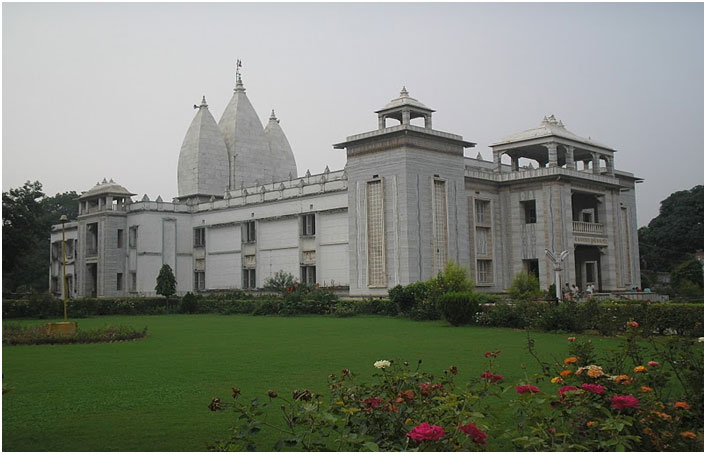
Constructed by a family of Varanasi, this modern temple is dedicated to Lord Rama. It is situated around the place where Tulsidas, the great medieval seer, lived and wrote the epic “Shri Ramcharitmanas”, which narrates the life of Lord Rama, the hero of the Ramayana. Verses from Tulsidas’s epic are inscribed on the walls.
Category Archives: Varanasi
Durga Temple
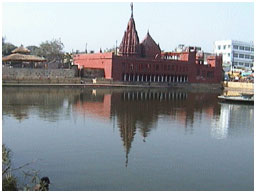 Godess Durga is considered as the goddess of strength and power. This temple was built in the 18th century with red stone work. A fine example of Nagara art. This temple falls on the main route from Railway Station to Benaras Hindu University, just before Tulsi Manas temple and Sankatmochan temple.
Godess Durga is considered as the goddess of strength and power. This temple was built in the 18th century with red stone work. A fine example of Nagara art. This temple falls on the main route from Railway Station to Benaras Hindu University, just before Tulsi Manas temple and Sankatmochan temple.
Sankat Mochan Hanuman Temple
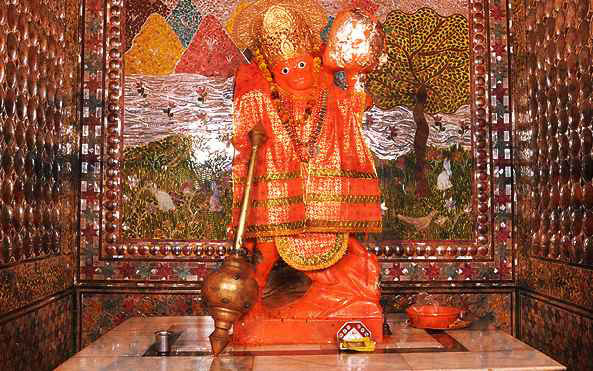
The Sankat Mochan Hanuman temple, which is situated by the Asi River, is one of the sacred temples of the Hanuman. According to historical legend, the temple was built on the spot where the saint Tulsidas had a vision of Hanuman.
Tulsidas & Sankatmochan temple:
Tulsidas, the great Indian poet is well renowned for his literary genius not only in India but also world over. He was born in Rajapur, Chitrakoot in year 1532. Tulsidas was left as an orphan since birth. In his childhood, he was taken care by his Guru Narharidas, a Vaishnava ascetic. Like any other student of his Guru he was given the diksha of Virakta sect. One interesting event of his life comes at the juncture of youth after his marriage to Ratnavali. When he heard that her wife left for visiting her parents, he immediately left worshiping in temple and immediately left to meet her at night. He crossed the overflooded Yamuna & ascended the balcony of his wife by using snake as a rope to meet her. His wife chided him saying that he appeared to be a saint and worshipper of Lord Ramachandra but if he just had half of the enthusiasm of attraction to my flesh body towards worshiping Lord Rama, you would achieve more results. Hearing this, Tulsidas underwent transformation and left at once for Prayag & renounced the household life. After renouncing, Tulsidas travelled all over India like Dwarka, Puri, Badrinath, Rameshwaram and many other places to discuss with saints enquiring the Absolute truth. He travelled to Mansarovar Lake where he met Kak Bhushundi (Saint crow) – one of the well known speaker of Ramayan. Having heard Ramayan directly from Kak Bhusandi, Tulsidas returned back. After this, he started to live permanently in Varanasi & started to recite Rama story for commoners. He used to visit nearby forest in the morning & used to throw the remaining water from his pot in the night at an old tree. On that tree, a ghost who being always thirsty was happy with this daily supply of water. Being pleased by Tulsidas, he spoke to him and asked him for a boon that his only desire was that He would like to see his Lord Rama. The ghost told him that it’s beyond his strength but at least he can help him to reach and locate Lord Rama’s devotee Hanuman. He told him that Hanumanji, in disguise, visited everyday to hear his Ramayan recitation. He should look for a person in the audience who comes first and leaves at the end thus understand him to be Hanuman. Next morning when he was reciting story he noticed a leper who was first to come & last to leave. He followed leper to the same forest near the place where today stands Sankatmochana temple. Tulsidas fell to the leper’s feet & said he knew who he was and that he should kindly not forsake him. Hanuman manifested his real form & told him that he should go to Chitrakut and that he can see his Rama in Chitrakoot. On his request, Tulsidas went to Chitrakut and stayed on banks of Mandakini and finally at last got the darshan of Lord Rama in Chitrakoot.
After this, Tulsidas came back and made the figure of Hanuman in Sankatmochan area by mud. In this temple area, he used to worship this deity daily & wrote his famous Hanuman Chalisa. He also began his life’s masterpiece Ramcharitamanas in Varanasi. When he completed the Ramcharitramanas, the pandits of Varanasi disrespected his work & to prove its credentials they kept the Ramcharitramanas at the bottom of four Vedas in Vishwanath temple at night and locked the door. In the next morning, when the doors were opened, Ramcharitramanas appeared on the top of the Vedas and proved its credentials. Thus Tulsidas’ glory spread far and wide. Finally Tulsidas died in 1632 at Assi Ghat in Varanasi.
The Kashi Vishwanath temple
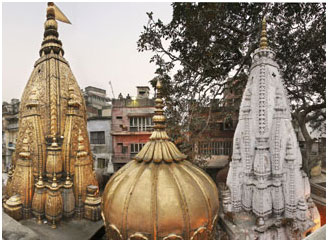
Also known as the Golden Temple, it is dedicated to Lord Shiva, the presiding deity of the city.
More than the Ghat’s and even the Ganga, the Shivalinga installed in the temple remains the devotional focus of Varanasi.
Kashi Vishwanath temple is one of the most famous temples and is dedicated to Lord Shiva. The temple stands on the western bank of the holy river Ganges and is one of the twelve Jyotirlingas, the holiest of Shiva temples. The main deity is known by the name Vishwanatha or Vishweshwara meaning Ruler of the universe. The temple town, which claims to be the oldest living city in the world, with 3500 years of documented history, is also called Kashi and hence the temple is popularly called Kashi Vishwanath temple. It has been destroyed and re-constructed a number of times in the history. The last structure was demolished by Aurangazeb, who constructed the Gyanvapi Mosque on its site. The current structure was built on an adjacent site by the Maratha monarch, Ahilya Bai Holkar of Indore in 1780. Since 1983, the temple has been managed by the government of Uttar Pradesh. During the religious occasion of Shivratri, Kashi Naresh (King of Kashi) is the chief officiating priest and no other person or priest is allowed to enter the sanctum sanctorum. It is only after he performs his religious functions that others are allowed to enter.
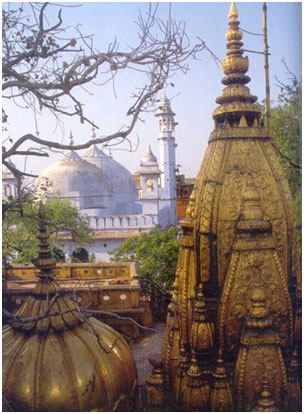
A simple glimpse of the Jyotirlinga is a soul-cleansing experience that transforms life and puts it on the path of knowledge and bhakti. Vishweshwara Jyotirlinga has a very special and unique significance in the spiritual history of India. Tradition has it that the merits earned by the darshan of other Jyotirlinga scattered in various parts of India accrue to devotee by a single visit to Kashi Vishwanath temple.
The temple has been visited by many great personalities- Lord Chaitanya, Lord Nityananda, Adi Shankaracharya, Goswami Tulsidas, Gurunanak, Srila Bhakti Siddhant Saraswati Thakur and several other spiritual personalities. The Kashi Vishwanath temple attracts visitors not only from India but abroad as well and thereby symbolizes man’s desire to live in peace and harmony with one another.
In 1839, Two domes of the temple were covered by gold donated by Punjab Kesari Maharaja Ranjeet Singh. Ministry of cultures & Religious affairs of U.P. Govt. took keen interest for gold plating of third dome of temple.
The temple opens daily at 2.30 a.m. Mangala Aarati takes place between 3 to 4 a.m. The ticket holders are permitted to join.
From 4 to 11 a.m: General darshan is allowed.
11.30 to 12 a.m: Mid-day Bhog Aarati is done.
Again 12 noon to 7 p.m: Devotees are free to have darshan.
From 7 to 8.30 p.m: Evening Sapta Rishi Aarati is done after which darshan is again possible until 9 p.m. when Shringar/Bhog Aarati starts.
After 9 p.m: Darshan from outside only is possible.
Shayana Aarti starts at 10.30 p.m. The temple closes at 11p.m.
| TEMPLE TIMINGS |
| TEMPLE | MANGLA | BHOG | SANDHYA | SRINGAR | SHAYAN |
| SRI VISHWANATH JI | 3.00A.M. | 1.30NOON | 7.00P.M. | 9.00P.M. | 10.30P.M. |
| SRI ANNAPURNA JI | 4.00A.M. | 11.30NOON | 7.00P.M. | 10.00P.M. | |
| SRI KALBHAIRO JI | 5.00A.M. | 01.30NOON | 8.00P.M. | 12.00P.M. | |
| SRI SANKATHA JI | 4.30/6.30A.M. | 02.30NOON | 11.00P.M. | 11.00P.M. | |
| SRI DURGA JI(DURGA KUNDA) | 5.00A.M. | 7.00P.M. | 11.00P.M. | ||
| SRI SANKAT MOCHAN | 4.30A.M. | 12.00NOON | 3.00P.M. | 8.00P.M. | 10.30P.M. |